Estimation of Relative Chlorophyll Content in Lettuce (Lactuca sativa L.) Leaves under Cadmium Stress Using Visible—Near-Infrared Reflectance and Machine-Learning Models
Abstract
1. Introduction
2. Materials and Methods
2.1. Experimental Materials
2.2. Experimental Design
2.3. Spectral Data Acquisition
2.4. Determination of Relative Chlorophyll Content
2.5. Data Processing and Analysis
2.5.1. Significance Analysis
2.5.2. Spectral Data Preprocessing
2.5.3. Methods for Feature Band Extraction
2.5.4. Machine-Learning Methods
2.5.5. Model Accuracy Evaluation Methods
3. Results and Discussion
3.1. Effects of Cadmium Stress on the SPAD Values of Lettuce Leaves
3.2. Spectral Characteristics of Lettuce Leaves under Cadmium Stress
3.3. Spectral Preprocessing
3.4. The Optimal Choice of Preprocessing
3.5. Feature Band Extraction
3.6. Feature Band Prediction Model Based on Support Vector Regression (SVR)
4. Conclusions
- As the cadmium stress intensity increases, the SPAD values of lettuce leaves gradually decrease while the spectral reflectance in the visible light range gradually increases. Therefore, it is feasible to use visible–near-infrared reflectance spectroscopy to invert the relative chlorophyll content of lettuce leaves.
- By preprocessing the original spectra using SG, MSC, SNV, MN, B, D, FD, and SD and then using PLSR to invert the SPAD values of lettuce leaves, it was found that the spectral accuracy for predicting SPAD values improved when using the D preprocessed spectra compared to the original spectra. The Rv2 and RMSEv were 0.87 and 1.16, respectively.
- By combining the feature bands selected using the correlation coefficient method with the SVR algorithm, it was found that the GA–SVR (sigmoid kernel function), PSO-SVR (Radial basis kernel function), and GS–SVR (Polynomial kernel function) models can estimate the SPAD values of lettuce leaves under cadmium stress. Among them, the GA–SVR (sigmoid kernel function) model exhibits the highest accuracy.
Author Contributions
Funding
Data Availability Statement
Conflicts of Interest
References
- Chen, Z.Q.; Liu, Q.Z.; Lin, Q.; Lu, L.M.; Lu, P.; Jin, H.Y.; Huang, L.L.; Yang, X.E. Evaluation of cadmium accumulation in different leafy vegetable cultivars and approaches for reducing accumulation. J. Agro-Environ. Sci. 2022, 41, 1671–1681. [Google Scholar]
- Liu, K.G.; Song, Y.P.; Zhang, L.L.; Gong, F.R. Comprehensive Comparison of Quality between Purple Leaf Lettuce and Green Leaf Lettuce. J. Change Veg. 2021, 6, 51–53. [Google Scholar]
- Wang, M.; Chen, Z.Q.; Chen, D.; Liu, L.; Hamid, Y.; Zhang, S.J.; Shan, A.Q.; Kang, K.J.; Feng, Y.; Yang, X.E. Combined cadmium and fluorine inhibit lettuce growth through reducing root elongation, photosynthesis, and nutrient absorption. Environ. Sci. Pollut. Res. Int. 2022, 29, 91255–91267. [Google Scholar] [CrossRef] [PubMed]
- Xiao, J.C.; Hui, F.T.; Yong, Z.W.; Xiao, M.X. Effects of Cadmium on metabolism of photosynthetic pigment and photosynthetic system in Lactuca sativa L. revealed by physiological and proteomics analysis. Sci. Hortic. 2022, 305, 111371. [Google Scholar]
- Li, M.; Hu, C.L.; Tao, G.L. Estimation of oil tea leaf SPAD values using hyperspectral remote sensing based on different preprocessing methods. J. Jiangsu For. Sci. Technol. 2022, 49, 1–5. [Google Scholar]
- Bei, C.; Jun, Q.Z.; Jiang, W.H.; Yu, X.S.; Chun, H.Y.; Feng, X.Z. Leaf chlorophyll content retrieval of wheat by simulated RapidEye, Sentinel-2 and EnMAP data. J. Integr. Agric. 2018, 18, 1230–1245. [Google Scholar]
- Cordon, G.; Lagorio, G.M.; Paruelo, M.J. Chlorophyll fluorescence, photochemical reflective index and normalized difference vegetative index during plant senescence. J. Plant Physiol. 2016, 199, 100–110. [Google Scholar] [CrossRef] [PubMed]
- Li, Z.; Zhang, F.; Chen, L.H.; Zhang, H.W. Research on Spectrum Variance of Vegetation Leaves and Estimation Model for Leaf Chlorophyll Content Based on the Spectral Index. Spectrosc. Spectr. Anal. 2018, 38, 1533–1539. [Google Scholar]
- Qi, H.L.; Wei, H.H.; Paul, J. Use of a SPAD-502 meter to measure leaf chlorophyll concentration in Arabidopsis thaliana. Photosynth. Res. 2011, 107, 209–214. [Google Scholar]
- Cao, Y.L.; Zou, H.D.; Zheng, W.; Jiang, K.L.; Yu, F.H. Study on Methods of Reducing Hyperspectral Data and Retrieving Chlorophyll Content from Rice Leaf. J. Shenyang Agric. Univ. 2019, 50, 101–107. [Google Scholar]
- Zhang, Z.R.; Chang, Q.R.; Zhang, T.L.; Ban, S.T.; You, M.M. Hyperspectral estimation of chlorophyll content of cotton canopy leaves based on Support Vector Machine. J. Northwest A F Univ. (Nat. Sci. Ed.) 2018, 46, 39–45. [Google Scholar]
- Yao, J.S.; Yang, H.Q.; He, Y. Nondestructive detection of rape leaf chlorophyll level based on Vis/NIR spectroscopy. J. Zhejiang Univ. (Agric. Life Sci.) 2009, 35, 433–438. [Google Scholar]
- Shao, Y.N.; Zhao, C.J.; Bao, Y.D.; He, Y. Quantification of Nitrogen Status in Rice by Least Squares Support Vector Machines and Reflectance Spectroscopy. Food Bioprocess Technol. 2012, 5, 100–107. [Google Scholar] [CrossRef]
- Vali, S.R.; Araz, N.S.; Ebrahim, T.; Ibham, V.; Antoni, S.; Adam, F. Prediction of winter wheat leaf chlorophyll content based on VIS/NIR spectroscopy using ANN and PLSR. Food Sci. Nutr. 2023, 11, 2166–2175. [Google Scholar]
- Tan, L.; He, B.Y.; Liu, W.G.; Pang, D. Estimation of chlorophyll content of Eremurus chinensis based on optimization support vector regression machine. Chin. J. Ecol. 2017, 36, 555–562. [Google Scholar]
- Tao, L.; Zhang, N.M. Growth Response of Three Leafy Vegetables to Cd Pollution and Their Cd Accumulation Characteristics. Chin. Agric. Sci. Bull. 2018, 34, 99–106. [Google Scholar]
- Sun, J.; Zhang, Y.C.; Mao, H.P.; Wu, X.H.; Chen, Y.; Wang, Q.P. Responses Analysis of Lettuce Leaf Pollution in Cadmium Stress Based on Computer Vision. Trans. Chin. Soc. Agric. Mach. 2018, 49, 166–172. [Google Scholar]
- Sun, Y.L.; Zhao, J.W.; Liu, X.S.; Li, S.Y.; Ma, C.H.; Wang, X.Z.; Zhang, Q.B. Effect of nitrogen application on photosynthetic daily variation, leaf morphology and dry matter yield of alfalfa at the early flowering growth stage. Acta Pratacult. Sin. 2022, 31, 63–75. [Google Scholar]
- Berens, M.L.; Wolinska, K.W.; Spaepen, S.; Ziegler, J.; Nobori, T.; Nair, A.; Krüler, V.; Winkelmüller, T.M.; Wang, Y.M.; Mine, A.; et al. Balancing trade-offs between biotic and abiotic stress responses through leaf age-dependent variation in stress hormone cross-talk. Proc. Natl. Acad. Sci. USA 2019, 116, 2364–2373. [Google Scholar] [CrossRef]
- Wang, J.; Chen, S.T.; Ding, S.C.; Yao, X.W.; Zhang, M.M.; Hu, Z.H. Relationships between the Leaf Respiration of Soybean and Vegetation Indexes and Leaf Characteristics. Spectrosc. Spectr. Anal. 2022, 42, 1607–1613. [Google Scholar]
- Kang, L.; Yuan, J.Q.; Gao, R.; Kong, Q.M.; Jia, Y.J.; Su, Z.B. Early detection and identification of rice blast based on hyperspectral image. Spectrosc. Spectr. Anal. 2021, 41, 898–902. [Google Scholar]
- Liu, J.; Chang, Q.R.; Liu, M.; Yin, Z.; Ma, W.J. Chlorophyll Content Inversion with Hyperspectral Technology for Apple Leaves Based on Support Vector Regression Algorithm. Trans. Chin. Soc. Agric. Mach. 2016, 47, 260–265+272. [Google Scholar]
- Leone, P.A.; Viscarra-Rossel, A.R.; Amenta, P.; Buondonno, A. Prediction of Soil Properties with PLSR and vis-NIR Spectroscopy: Application to Mediterranean Soils from Southern Italy. Curr. Anal. Chem. 2012, 8, 283–299. [Google Scholar] [CrossRef]
- RebeccaJo, V.; Bhogilal, H.V.; Doug, A.; Chao, C.S.; Adam, G.; Viacheslav, A.; Asim, B. Evaluation of Optimized Preprocessing and Modeling Algorithms for Prediction of Soil Properties Using VIS-NIR Spectroscopy. Sensors 2021, 21, 6745. [Google Scholar]
- Ren, X.; Lao, C.L.; Xu, Z.L.; Jin, Y.; Guo, Y.; Li, J.H.; Yang, Y.H. The Study of the Spectral Model for Estimating Pigment Contents of Tobacco Leaves in Field. Spectrosc. Spectr. Anal. 2015, 35, 1654–1659. [Google Scholar]
- Zheng, G.H.; Xiao, T.Z.; Meng, Y.L.; Tian, Q.M.; Zhi, C.L. Prediction of Carbon Emission of the Transportation Sector in Jiangsu Province-Regression Prediction Model Based on GA-SVM. Sustainability 2023, 15, 3631. [Google Scholar]
- Zhou, X.X.; Li, N.; Pan, Y.Z.; Sun, L.X. Optimized SVR based on artificial bee colony algorithm for leaf area index inversion. Natl. Remote Sens. Bull. 2022, 26, 766–780. [Google Scholar] [CrossRef]
- Yu, K.L.; Meng, Q.M.; Zou, J.H. Effects of Cd2+ on Seedling Growth, Chlorophyll Contents and Ultrastructures in Maize. Acta Agric. Boreali-Sin. 2010, 25, 118–123. [Google Scholar]
- Wu, Y.Y.; Deng, S.Q.; Liu, S.Q.; Luo, H.B.; Yi, Z.X.; Deng, M. Effects of cadmium stress on the growth and physiological characteristics of maize seedlings from different varieties. J. Hunan Agric. Univ. (Nat. Sci.) 2023, 49, 509–515. [Google Scholar]
- Zhou, L.; Zhou, L.; Wu, H.; Kong, L.; Li, J.; Qiao, J.; Chen, L. Analysis of Cadmium Contamination in Lettuce (Lactuca sativa L.) Using Visible-Near Infrared Reflectance Spectroscopy. Sensors 2023, 23, 9562. [Google Scholar] [CrossRef]
- Yu, J.Y.; Chang, Q.R.; Ban, S.T.; Tian, M.L.; You, M.M. Hyperspectral models for estimating SPAD values of kiwifruit leaves. Agric. Res. Arid Areas 2018, 36, 168–174. [Google Scholar]
- Shu, T.; Li, R.; Chen, Z.; Sun, C.; Liu, C.; Xu, Y. Study on spectral characteristics and SPAD value estimation model of Cucurbita ficifolia leaf. Jiangsu Agric. Sci. 2023, 51, 222–227. [Google Scholar]
- Ma, D.H.; Ke, C.Q. Research on Spectral Characteristics of Winter Typical Vegetation in Nanjing. Remote Sens. Technol. Appl. 2016, 31, 702–708. [Google Scholar]
- Huang, M.G.; Wang, X.H.; Ma, L.L.; Ye, X.H.; Zhu, X.H.; Kong, W.P.; Wang, N.; Wang, Q.; Ouyang, G.Z.; Zheng, Q.C.; et al. Research progress on remote sensing discrimination techniques for grassland botanical species. Acta Pratacult. Sin. 2023, 32, 167–185. [Google Scholar]
- Feng, W.; Guo, T.C.; Xie, Y.X.; Wang, Y.H.; Zhu, Y.J.; Wang, C.Y. Spectrum Analytical Technique and Its Applications for the Crop Growth Detection. Chin. Agric. Sci. Bull. 2009, 25, 182–188. [Google Scholar]
- Xin, Z.; Jun, S.; Yan, T.; Quan, S.C.; Xiao, H.W.; Ying, Y.H. A deep learning based regression method on hyperspectral data for rapid prediction of cadmium residue in lettuce leaves. Chemom. Intell. Lab. Syst. 2020, 200, 103996. [Google Scholar] [CrossRef]
- Wang, J.Y.; Xie, S.S.; Gai, J.Y.; Wang, Z.T. Hyperspectral Prediction Model of Chlorophyll Content in Sugarcane Leaves Under Stress of Mosaic. Spectrosc. Spectr. Anal. 2023, 43, 2885–2893. [Google Scholar]
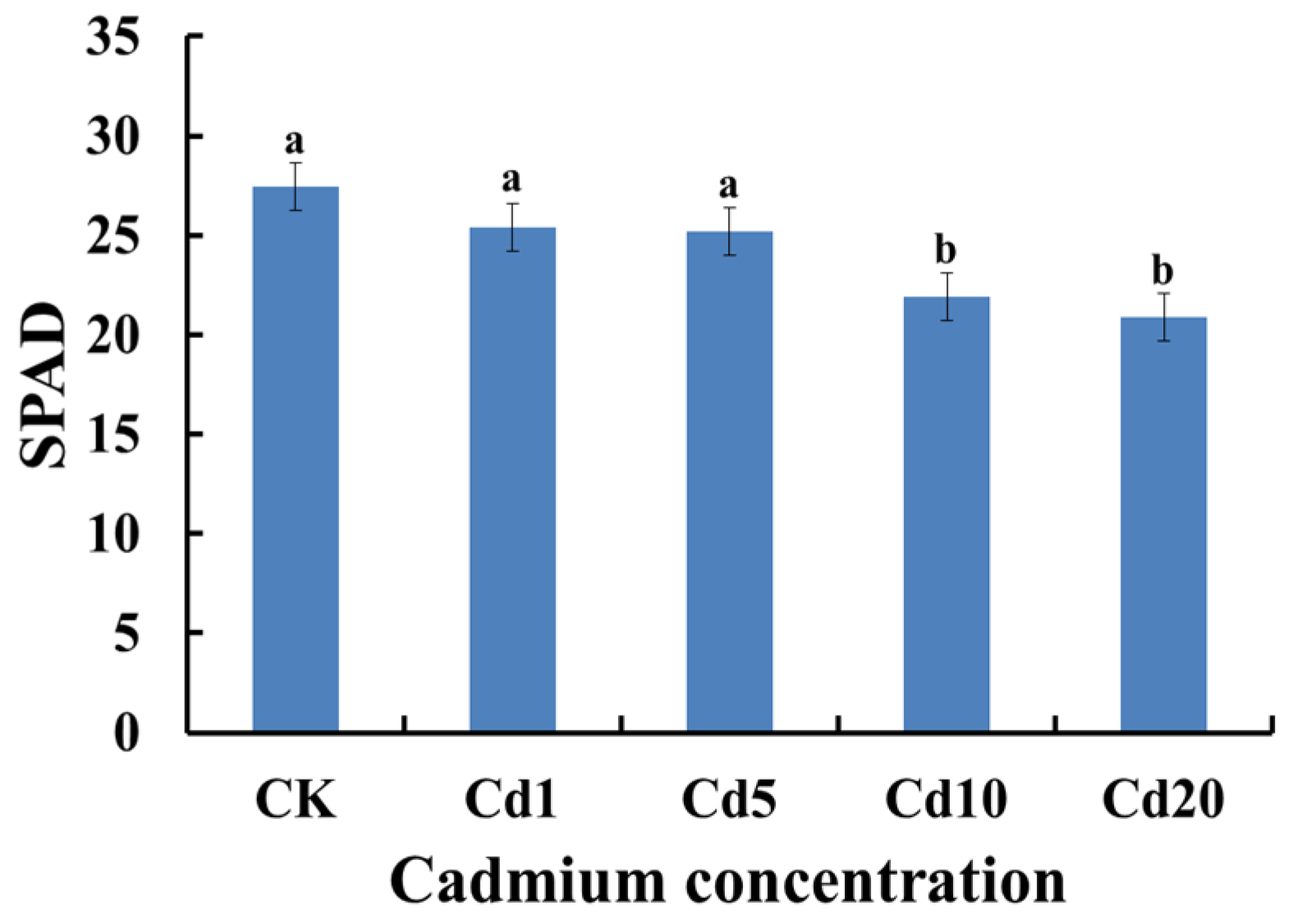
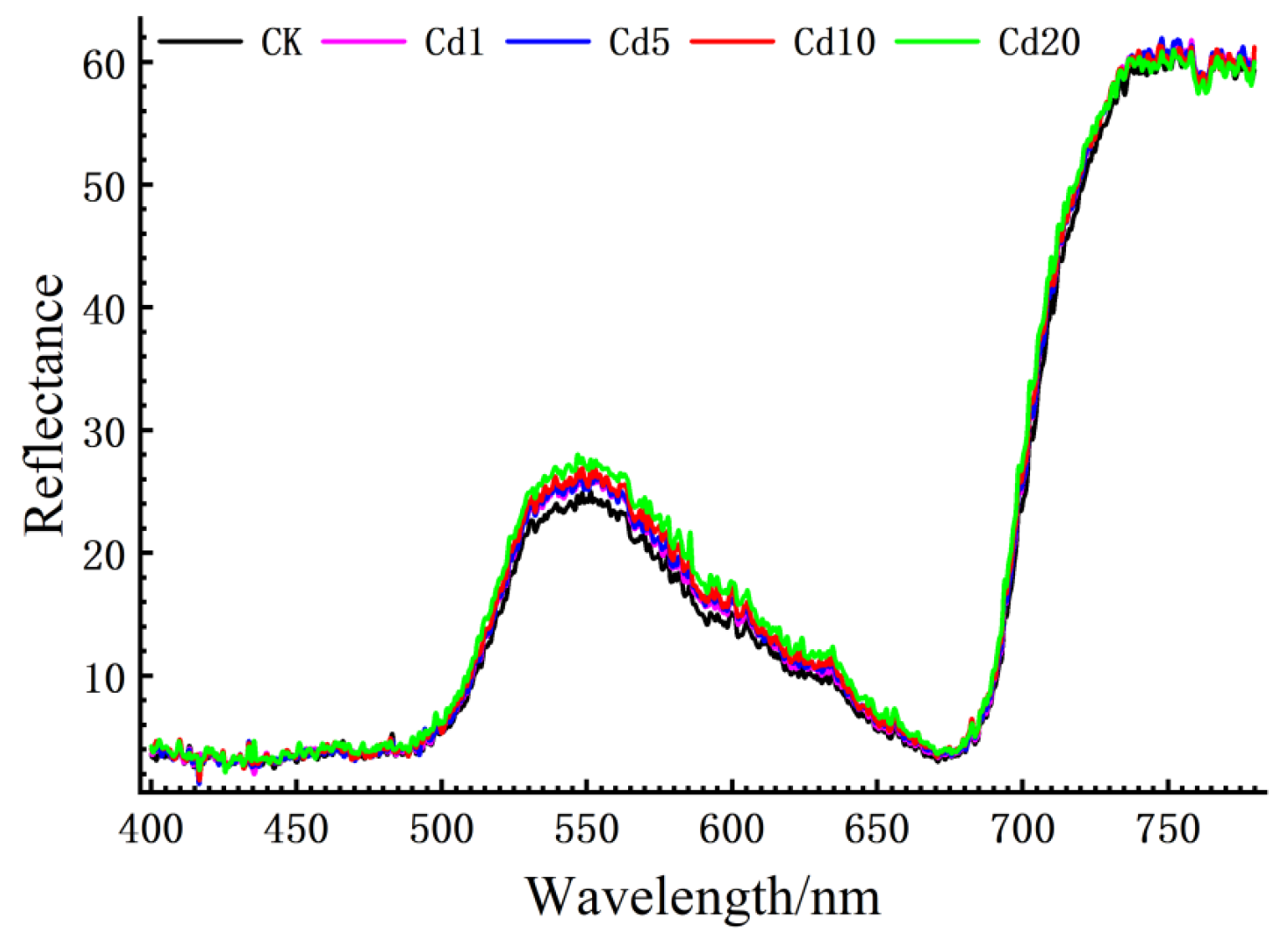
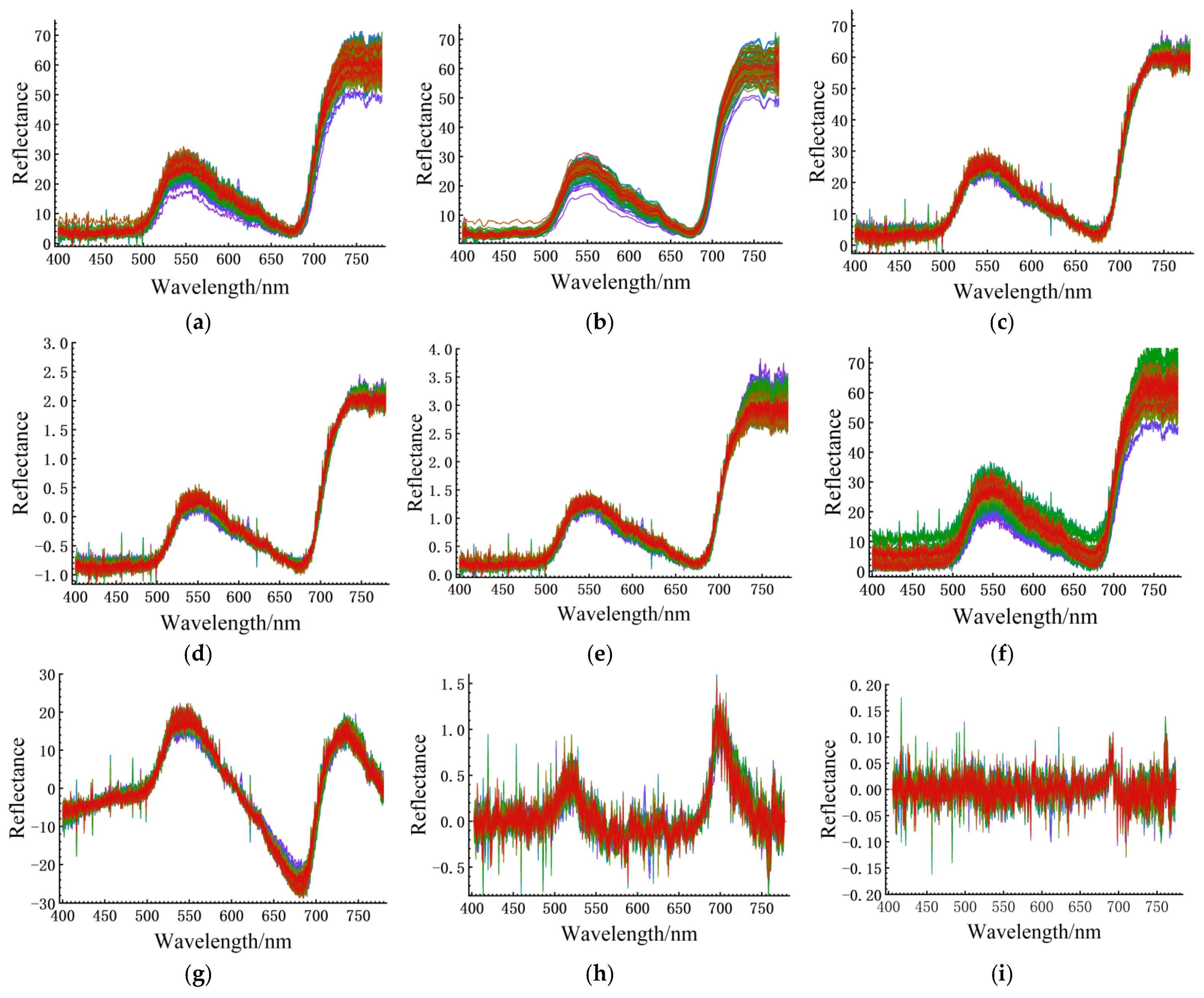
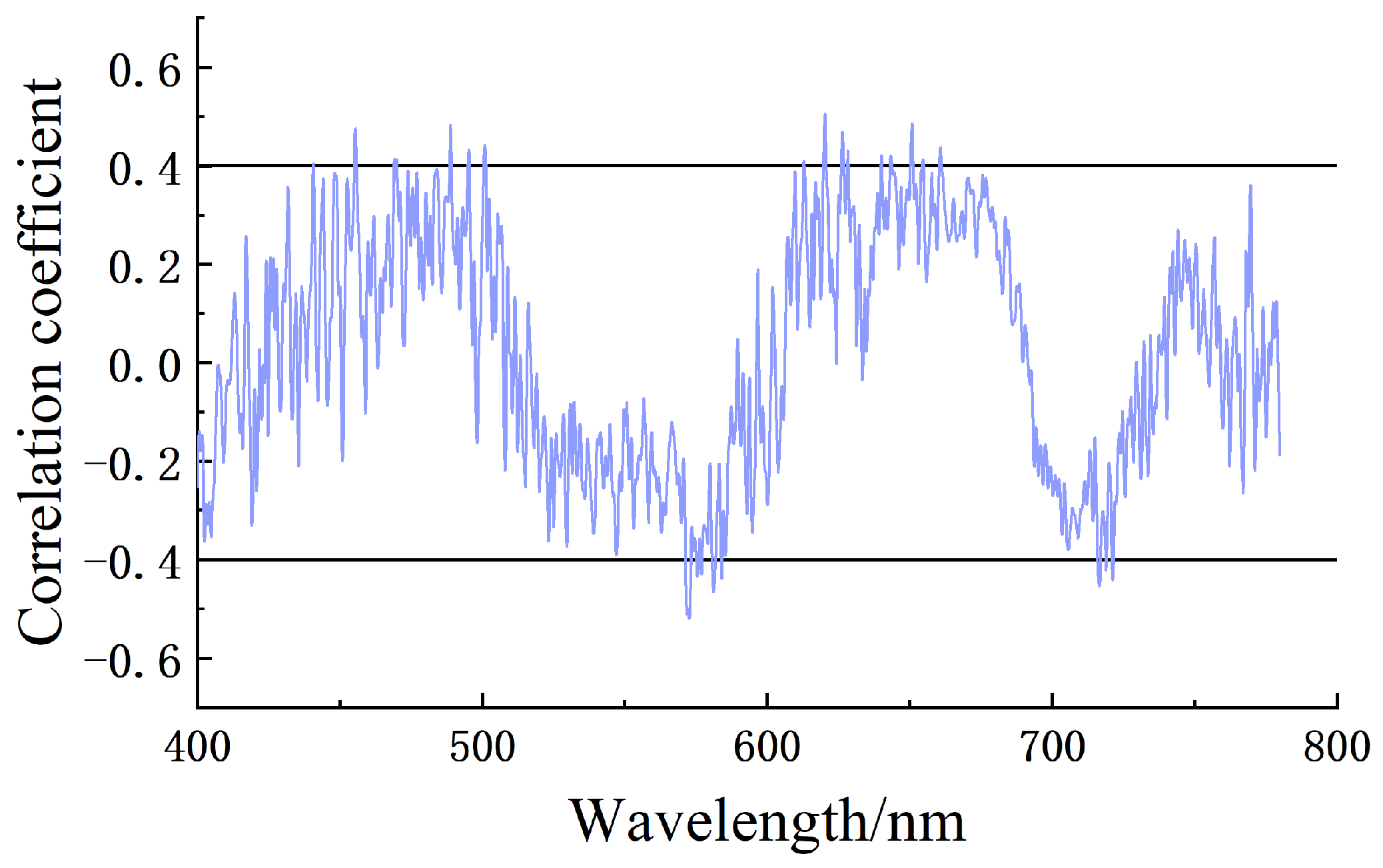
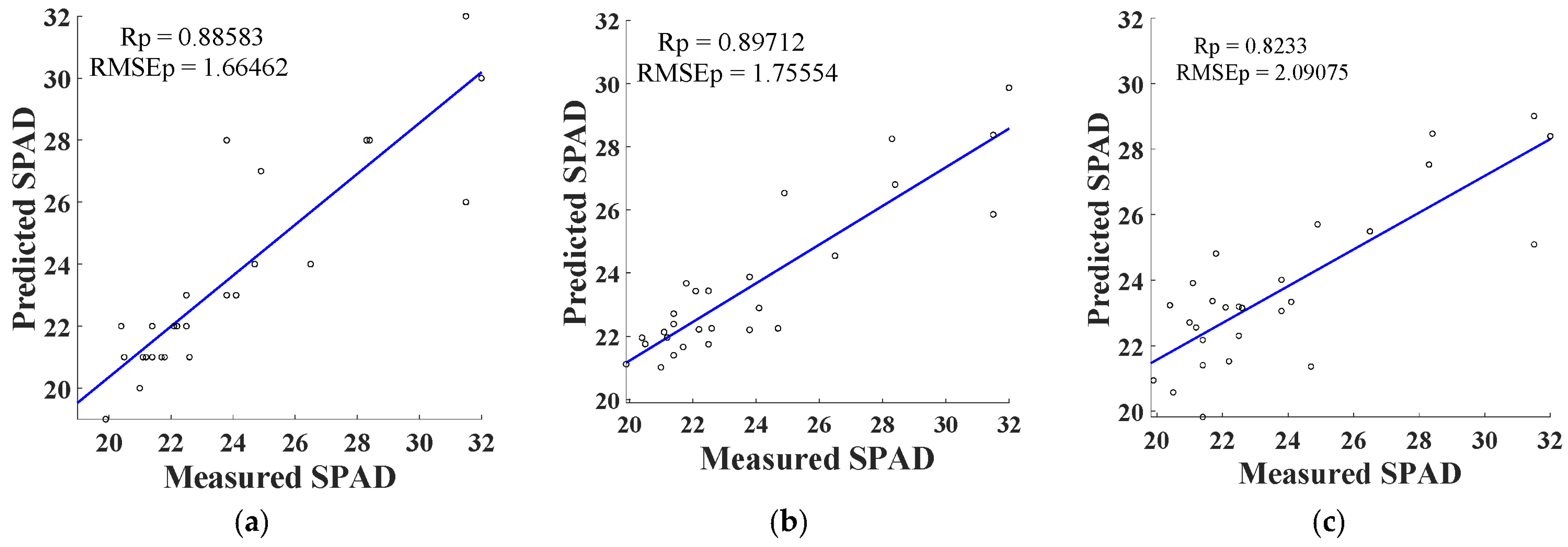
| Preprocessing Method | Number of Principal Components | Training Set | Testing Set | ||
|---|---|---|---|---|---|
| R2 | RMSE | Rv2 | RMSEv | ||
| original spectral | 7 | 0.91 | 0.95 | 0.85 | 1.27 |
| SG | 10 | 0.90 | 1.00 | 0.81 | 1.41 |
| MSC | 10 | 0.90 | 1.03 | 0.82 | 1.39 |
| SNV | 11 | 0.94 | 0.81 | 0.84 | 1.31 |
| NM | 7 | 0.90 | 1.03 | 0.82 | 1.38 |
| B | 7 | 0.92 | 0.92 | 0.85 | 1.25 |
| D | 8 | 0.94 | 0.82 | 0.87 | 1.16 |
| FD | 10 | 0.90 | 1.00 | 0.82 | 1.37 |
| SD | 9 | 0.89 | 1.09 | 0.81 | 1.42 |
| Models | Kernel Functions | Penalty Parameter c | Kernel Parameter g | Training Set | Testing Set | ||
|---|---|---|---|---|---|---|---|
| R2 | RMSE | Rp2 | RMSEp | ||||
| GA–SVR | Linear kernel function | 4.84 | 82.40 | 0.98 | 0.27 | −0.65 | 3.67 |
| Polynomial kernel function | 4.62 | 0.31 | 0.53 | 2.00 | 0.34 | 2.75 | |
| Radial basis kernel function | 4.44 | 3.12 | 0.97 | 0.33 | 0.74 | 1.79 | |
| Sigmoid kernel function | 6.74 | 3.53 | 0.98 | 0.27 | 0.77 | 1.66 | |
| PSO-SVR | Linear kernel function | 5.86 | 0.10 | 0.68 | 1.78 | 0.60 | 2.25 |
| Polynomial kernel function | 5.86 | 0.10 | 1.00 | 0.14 | −0.85 | 4.69 | |
| Radial basis kernel function | 5.86 | 0.10 | 0.95 | 0.71 | 0.75 | 1.76 | |
| Sigmoid kernel function | 5.86 | 0.10 | −0.01 | 3.20 | 0.00 | 3.57 | |
| GS–SVR | Linear kernel function | 4.00 | 0.25 | 0.66 | 1.84 | 0.61 | 2.24 |
| Polynomial kernel function | 4.00 | 0.25 | 0.69 | 1.77 | 0.66 | 2.09 | |
| Radial basis kernel function | 4.00 | 0.25 | 0.67 | 1.81 | 0.63 | 2.15 | |
| Sigmoid kernel function | 4.00 | 0.25 | 0.39 | 2.47 | 0.40 | 2.76 | |
Disclaimer/Publisher’s Note: The statements, opinions and data contained in all publications are solely those of the individual author(s) and contributor(s) and not of MDPI and/or the editor(s). MDPI and/or the editor(s) disclaim responsibility for any injury to people or property resulting from any ideas, methods, instructions or products referred to in the content. |
© 2024 by the authors. Licensee MDPI, Basel, Switzerland. This article is an open access article distributed under the terms and conditions of the Creative Commons Attribution (CC BY) license (https://creativecommons.org/licenses/by/4.0/).
Share and Cite
Zhou, L.; Wu, H.; Jing, T.; Li, T.; Li, J.; Kong, L.; Zhou, L. Estimation of Relative Chlorophyll Content in Lettuce (Lactuca sativa L.) Leaves under Cadmium Stress Using Visible—Near-Infrared Reflectance and Machine-Learning Models. Agronomy 2024, 14, 427. https://doi.org/10.3390/agronomy14030427
Zhou L, Wu H, Jing T, Li T, Li J, Kong L, Zhou L. Estimation of Relative Chlorophyll Content in Lettuce (Lactuca sativa L.) Leaves under Cadmium Stress Using Visible—Near-Infrared Reflectance and Machine-Learning Models. Agronomy. 2024; 14(3):427. https://doi.org/10.3390/agronomy14030427
Chicago/Turabian StyleZhou, Leijinyu, Hongbo Wu, Tingting Jing, Tianhao Li, Jinsheng Li, Lijuan Kong, and Lina Zhou. 2024. "Estimation of Relative Chlorophyll Content in Lettuce (Lactuca sativa L.) Leaves under Cadmium Stress Using Visible—Near-Infrared Reflectance and Machine-Learning Models" Agronomy 14, no. 3: 427. https://doi.org/10.3390/agronomy14030427
APA StyleZhou, L., Wu, H., Jing, T., Li, T., Li, J., Kong, L., & Zhou, L. (2024). Estimation of Relative Chlorophyll Content in Lettuce (Lactuca sativa L.) Leaves under Cadmium Stress Using Visible—Near-Infrared Reflectance and Machine-Learning Models. Agronomy, 14(3), 427. https://doi.org/10.3390/agronomy14030427





